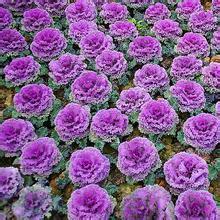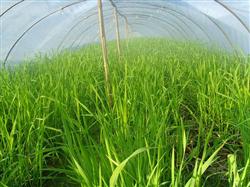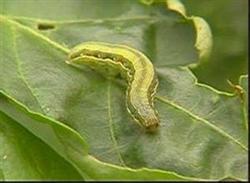Cultivation techniques of purple cabbage in spring

Purple cabbage has good cold resistance, compact heading, bright color, strong adaptability, high yield and good quality. it is suitable for cultivation in open field and protected field, with a yield of 2500-3000 kg per mu. 1. Variety selection: Zigan No. 1, Zaohong, Hongmu and other varieties with strong winter and early spring sowing were selected. 2. Sowing and raising seedlings: the seedlings can be sowed from the middle of December to the middle of March in Nanjing, and the suitable sowing time is the middle of December. Each mu of field needs 16 square meters of seedbed and 50 grams of seeds. Before sowing, 20 kg of urea and 40 kg of compound fertilizer were applied per mu, and shallow ploughing was done twice. Sow the seeds, pour water after sowing, cover with plastic film to increase the bed temperature and promote the seed germination. Uncover the film after emergence. Seedling broken heart and 2-leaf stage of each seedling once, seedling distance of 6 cm, pay attention to dense sparse, weak and strong. The seedlings were watered and fertilized according to the weather conditions to promote the healthy growth of the seedlings. In the early stage of the seedling bed, pay attention to ventilation during the day, keep the greenhouse temperature at 15-20 ℃, and keep the greenhouse temperature at about 5 ℃ at night. The seedlings were refined at low temperature before planting, and the temperature was reduced as much as possible without freezing damage, so as to adapt to the open field environment in early spring. 3. Site selection and planting: choose the land with leeward to the sun, high dryness, good drainage, fertile and loose land for planting. 5000 kg of rotten barnyard manure and 100kg of compound fertilizer are applied per mu. After fertilization, the land is ploughed, leveled and cultivated in deep ditches with a width of 2 meters. Around February 28th, the seedlings were planted with a height of 15 cm and 6-7 true leaves, with a row spacing of 40 cm and 4000 plants per mu. After planting, the roots are watered and rewatered in time to ensure that the trees are alive. 4. Field management: after cabbage planting, in addition to watering slow seedlings, generally do not water more. 7-10 days after planting, the greenhouse temperature was kept at 25-27 ℃ during the day and 13-15 ℃ at night, and the roots were ploughed twice to promote root development. Watering from seedling stage to rosette stage is based on the principle that the soil is dry and wet. The early-maturing varieties in the late rosette stage should squat seedlings properly to control the excessive growth of stems and leaves and early bolting. Keep the soil moist during the heading period, apply 15 kg of urea and 10 kg of phosphorus and potassium fertilizer per mu combined with watering, or spray 0.2% potassium dihydrogen phosphate solution twice with an interval of 7-10 days. In the middle stage of plant growth, spraying ABT Zengchanling 6 mg / L, high yield hormone 2000 times, spray Shibao 5000 times solution and so on to regulate plant growth. Early-maturing varieties have short heading period, rapid weight gain in early stage, early topdressing, and no topdressing in the middle of heading. 5. Prevention and control of diseases and insect pests: soft rot is easy to occur during the heading period, and the diseased plants are removed in time. At the initial stage of the disease, 72% agricultural streptomycin sulfate soluble powder is sprayed with 3500 times, once every 7-10 days, for 3 consecutive times. To control cabbage insects, spray with 40 ml of 5% cypermethrin EC and 60 kg of water per mu. To control Plutella xylostella, spray 0.5% avermectin wettable powder 60 grams plus water 60 kilograms per mu. To control aphids, spray 15 grams of imidacloprid wettable powder and 60 kilograms of water per mu. 6. Timely harvest: leaf bulbs are harvested in real time from early June to early July and finished within one month to avoid cracking or decay.
- Prev

Key points of protected cultivation and management of Zizania caduciflora in greenhouse at present
In the early spring of this year, the growth process of protected cultivation of Zizania caduciflora in greenhouse was 5-7 days later than usual due to the rare continuous rain and low temperature in history. It is necessary to seize the interval of sunny days to step up the field management of Zizania caduciflora cultivation in greenhouse facilities, and speed up the healthy growth of Zizania caduciflora under greenhouse facilities.
- Next

How to control cabbage armyworm
Cabbage armyworm (cabbagemoth) is alias cabbage night burglar, cabbage armyworm, Latin name: MamestrabrassicaeLinnaeus belongs to Lepidoptera, Noctuidae. Cabbage night moth has a variety of food habits. It is known that there are more than 100 species in 45 families. The main vegetables are cabbage, cauliflower, cabbage, radish, rape, eggplant fruits, beans,.
Related
- Where is it suitable to grow horseradish in China? it is expected to see the middle altitude horseradish in Alishan.
- How to prevent tomato virus disease reasonably? (Control methods included)
- Many people like to plant towel gourd on the balcony. What are the main points of this method and management?
- What crops can chili peppers be mixed with?
- Fertilization techniques and matters needing attention in Tomato
- What are the grafting techniques for peach seedlings in spring?
- Harm and control methods of root swelling disease of Chinese cabbage
- What are the pests of sweet potatoes? How to prevent and cure it?
- Symptoms, causes and Control methods of navel Rot in Tomato
- The cause of "Cucumber rotten bibcock" in Farmers' planting Cucumber and its Control Plan

